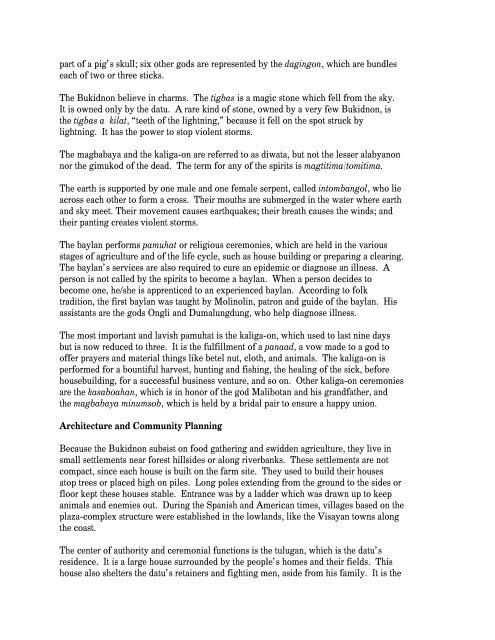Create successful ePaper yourself
Turn your PDF publications into a flip-book with our unique Google optimized e-Paper software.
part of a pig’s skull; six other gods are represented by the dagingon, which are bundles<br />
each of two or three sticks.<br />
The <strong>Bukidnon</strong> believe in charms. The tigbas is a magic stone which fell from the sky.<br />
It is owned only by the datu. A rare kind of stone, owned by a very few <strong>Bukidnon</strong>, is<br />
the tigbas a kilat, “teeth of the lightning,” because it fell on the spot struck by<br />
lightning. It has the power to stop violent storms.<br />
The magbabaya and the kaliga-on are referred to as diwata, but not the lesser alabyanon<br />
nor the gimukod of the dead. The term for any of the spirits is magtitima/tomitima.<br />
The earth is supported by one male and one female serpent, called intombangol, who lie<br />
across each other to form a cross. Their mouths are submerged in the water where earth<br />
and sky meet. Their movement causes earthquakes; their breath causes the winds; and<br />
their panting creates violent storms.<br />
The baylan performs pamuhat or religious ceremonies, which are held in the various<br />
stages of agriculture and of the life cycle, such as house building or preparing a clearing.<br />
The baylan’s services are also required to cure an epidemic or diagnose an illness. A<br />
person is not called by the spirits to become a baylan. When a person decides to<br />
become one, he/she is apprenticed to an experienced baylan. According to folk<br />
tradition, the first baylan was taught by Molinolin, patron and guide of the baylan. His<br />
assistants are the gods Ongli and Dumalungdung, who help diagnose illness.<br />
The most important and lavish pamuhat is the kaliga-on, which used to last nine days<br />
but is now reduced to three. It is the fulfillment of a panaad, a vow made to a god to<br />
offer prayers and material things like betel nut, cloth, and animals. The kaliga-on is<br />
performed for a bountiful harvest, hunting and fishing, the healing of the sick, before<br />
housebuilding, for a successful business venture, and so on. Other kaliga-on ceremonies<br />
are the kasaboahan, which is in honor of the god Malibotan and his grandfather, and<br />
the magbabaya minumsob, which is held by a bridal pair to ensure a happy union.<br />
Architecture and Community Planning<br />
Because the <strong>Bukidnon</strong> subsist on food gathering and swidden agriculture, they live in<br />
small settlements near forest hillsides or along riverbanks. These settlements are not<br />
compact, since each house is built on the farm site. They used to build their houses<br />
atop trees or placed high on piles. Long poles extending from the ground to the sides or<br />
floor kept these houses stable. Entrance was by a ladder which was drawn up to keep<br />
animals and enemies out. During the Spanish and American times, villages based on the<br />
plaza-complex structure were established in the lowlands, like the Visayan towns along<br />
the coast.<br />
The center of authority and ceremonial functions is the tulugan, which is the datu’s<br />
residence. It is a large house surrounded by the people’s homes and their fields. This<br />
house also shelters the datu’s retainers and fighting men, aside from his family. It is the
















